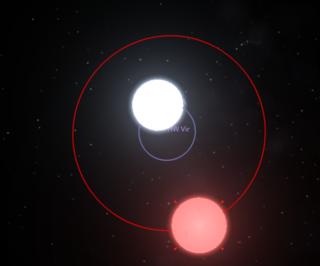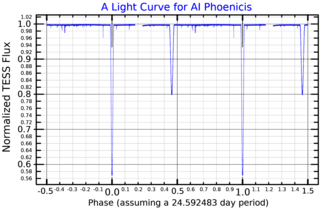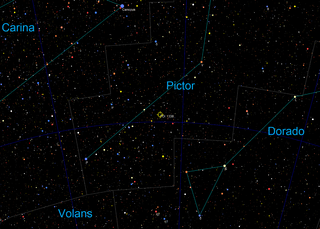WASP-7, also identified as HD 197286, is a type F star located about 520 light years away in the constellation Microscopium. This star is a little larger and about 28% more massive than the Sun and is also brighter and hotter. At magnitude 9 the star cannot be seen by the naked eye but is visible through a small telescope.

HW Virginis, abbreviated HW Vir, is an eclipsing binary system, approximately 563 light-years away based on the parallax measured by the Gaia spacecraft, in the constellation of Virgo. The system comprises an eclipsing B-type subdwarf star and red dwarf star. The two stars orbit each other every 0.116795 days.

A circumbinary planet is a planet that orbits two stars instead of one. The two stars orbit each other in a binary system, while the planet typically orbits farther from the center of the system than either of the two stars. In contrast, circumstellar planets in a binary system have stable orbits around one of the two stars, closer in than the orbital distance of the other star. Studies in 2013 showed that there is a strong hint that a circumbinary planet and its stars originate from a single disk.

Kepler-16b is a Saturn-mass exoplanet consisting of half gas and half rock and ice. It orbits a binary star, Kepler-16, with a period of 229 days. "[It] is the first confirmed, unambiguous example of a circumbinary planet – a planet orbiting not one, but two stars," said Josh Carter of the Center for Astrophysics | Harvard & Smithsonian, one of the discovery team.

Planet Hunters is a citizen science project to find exoplanets using human eyes. It does this by having users analyze data from the NASA Kepler space telescope and the NASA Transiting Exoplanet Survey Satellite. It was launched by a team led by Debra Fischer at Yale University, as part of the Zooniverse project.

AI Phoenicis is a variable star in the constellation of Phoenix. An Algol-type eclipsing binary, its apparent magnitude is constant at 8.58 for most of the time, sharply dropping to 9.35 during primary eclipse and to 8.89 during secondary eclipse. The system's variability was discovered by W. Strohmeier in 1972. From parallax measurements by the Gaia spacecraft, the system is located at a distance of 560 light-years from Earth, in agreement with earlier estimates based on its luminosity.
WASP-29 is a binary star system 285 light-years away in the constellation of Phoenix. The primary star is a K-type main-sequence star. Its comoving companion, a red dwarf star, was discovered in 2021. The star system kinematically belongs to the thin disk of the Milky Way. The primary is an old star with small starspot activity and low x-ray flux.
WASP-26 is a yellow main sequence star in the constellation of Cetus.
WASP-78, is a single F-type main-sequence star about 2350 light-years away. It is likely to be younger than the Sun at 3.4+1.5
−0.8 billion years. WASP-78 is depleted in heavy elements, having a 45% concentration of iron compared to the Sun.
BD-07 436, also known as WASP-77 since 2012, is a binary star system about 344 light-years away. The star's components appears to have a different age, with the secondary older than 9 billion years, while the primary's age is 5 billion years. The BD-07 436 system's concentration of heavy elements is similar to the Sun. Its stars display moderate chromospheric activity, including x-ray flares.
WASP-72 is the primary of a binary star system. It is an F7 class dwarf star, with an internal structure just on the verge of the Kraft break. It is orbited by a planet WASP-72b. The age of WASP-72 is younger than the Sun at 3.55±0.82 billion years.
WASP-62, formally named Naledi, is a single star about 573 light-years away. It is an F class main-sequence star, orbited by a planet, WASP-62b. The age of WASP-62 is much younger than the Sun at 0.8±0.6 billion years, and it has a metal abundance similar to the Sun.
WASP-61 is a single F-type main-sequence star about 1560 light-years away. The star is likely younger than the Sun at approximately 3.8+1.8
−0.9 billion years. WASP-61 is depleted in heavy elements, having just 40% of the solar abundance of iron.











